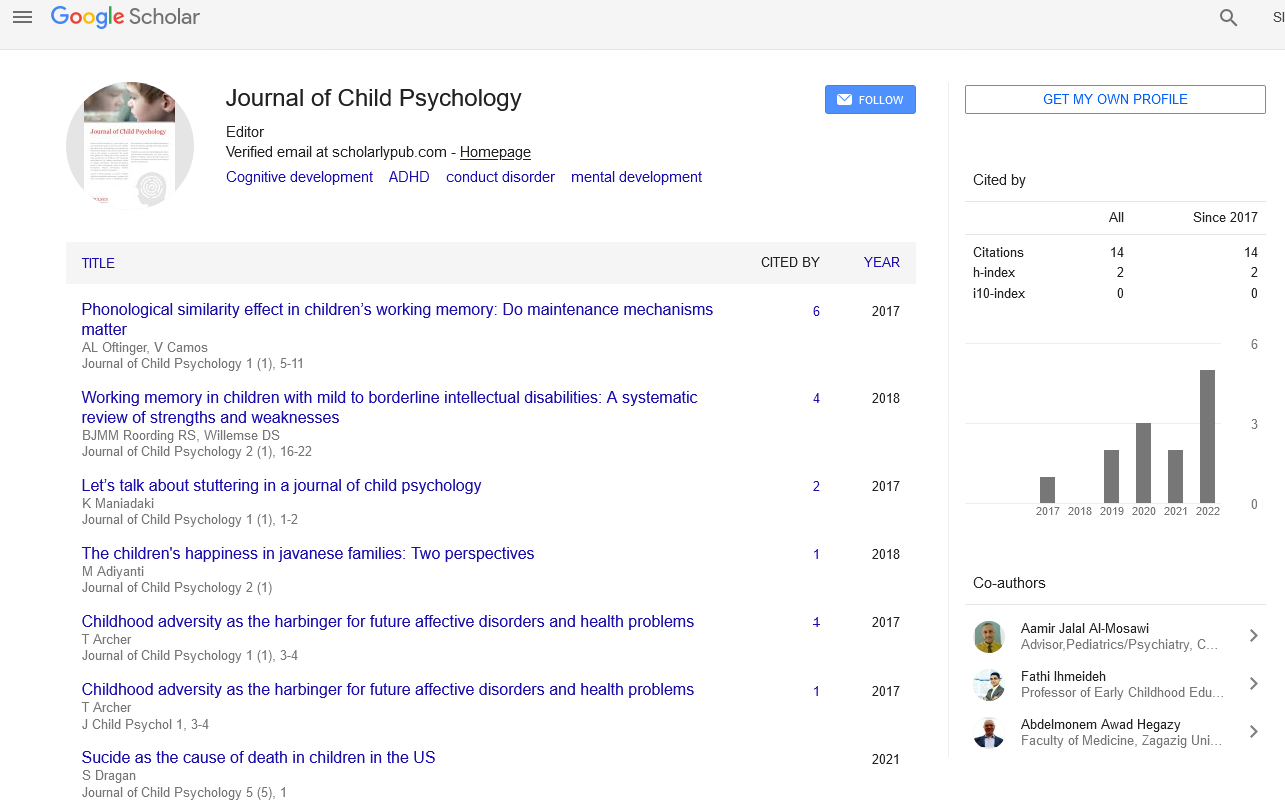How do adolescents deal with social anxiety?
Received: 28-Dec-2022, Manuscript No. PULJCP-22-6004 ; Editor assigned: 31-Dec-2022, Pre QC No. PULJCP-22-6004 (PQ); Accepted Date: Jan 20, 2023; Reviewed: 07-Jan-2023 QC No. PULJCP-22-6004 (Q); Revised: 11-Jan-2023, Manuscript No. PULJCP-22-6004 (R); Published: 25-Jan-2023, DOI: 10.37532/PULJCP.2023.7(1).20-21
Citation: Alam N. How do adolescents deal with social anxiety?. J Child Psychol. 2023;7(1):20-21
This open-access article is distributed under the terms of the Creative Commons Attribution Non-Commercial License (CC BY-NC) (http://creativecommons.org/licenses/by-nc/4.0/), which permits reuse, distribution and reproduction of the article, provided that the original work is properly cited and the reuse is restricted to noncommercial purposes. For commercial reuse, contact reprints@pulsus.com
Abstract
One of the most prevalent mental health conditions in the globe is anxiety disorders. Social anxiety disorder is an anxiety condition with early onset, frequent occurrence, and substantial severity among these psychological problems. Social anxiety is an issue that typically manifests in adolescence and has a negative impact on young people's social lives. Due to the significance of adolescence for a person's entire life, it is important to focus on this type of mental illness in order to develop precise prevention strategies and assist patients in their social life experiences. On the other side, social anxiety disorder frequently coexists with other mental health issues such depression, alcoholism, substance abuse, suicide, and multiple anxiety disorders. Therefore, social anxiety disorder prevention and treatment aid in preventing significant comorbid issues. First, specialists on social anxiety disorder employ pharmacologic treatments and therapies as common and efficient forms of treatment. There are, however, a number of obstacles in various dimensions to treatment. This review paper looks at adolescent social anxiety disorder. Second, treatment is provided for co-occurring disorders with social anxiety disorder. The procedure of prevention and therapy as well as any obstacles before treatment are then described.
Keywords
Adolescence, Comorbidity, Social anxiety disorder, Teenagers, Children
INTRODUCTION
In certain ways, it is expected and reasonable that some social situations would make people feel uneasy and apprehensive. Everyone has probably experienced embarrassment, stage fright, or perhaps even having their tongues tied during a talk at some point. An anxiety disorder has developed if these kinds of events start to become commonplace in daily life and have a severe impact on one's ability to communicate and build relationships. In the medical community, this illness is known as a Social Anxiety Disorder (SAD). Anxiety disorders affect over 3.6% of the world's population in 2015, according to research by the World Health Organization (WHO) titled "Depression and Other Common Mental Disorders." According to estimates, there are 264 million people worldwide who suffer from anxiety disorders, and the rate of growth between 2005 and 2015 was 14.9%. When examining the prevalence of various mental illnesses, anxiety disorders including separation anxiety disorder, generalized anxiety disorder, SAD, and panic disorder with or without agoraphobia are the most common. Clinical psychiatrists may not devote as much attention to patients with anxiety disorders, who are frequently treated as outpatients, as they do to those with other illnesses like schizophrenia or bipolar affective disorders, which require in-patient therapy but are less common.
Most adults between the ages of 18 and 29 report showing signs of anxiety or despair, according to the Centers for Disease Control and Prevention. Social anxiety is more likely to occur in adolescents. It has been shown that social anxiety makes college-aged kids less socially adept and less supportive of one another. In a recent study, it was discovered that 28.6% of university students tested severely and 10% tested moderately for DSM-5 social anxiety symptoms. Men who had a middle-of-the-road score were more likely to have experienced social anxiety as adolescents or early children. Additionally, boys with higher scores were more likely to display behavioral inhibition (such as shyness or avoiding social situations). Children's SAD frequently develops as a result of early life experiences. A little more than half of the people who have the condition believe it began before adolescence, and many of them recall having "always been this way." Others say that it begins in adolescence or shortly thereafter. As an early-experienced disorder, SAD also causes several issues, and it gets harder to manage as more comorbid conditions like substance misuse or serious depression emerge.
One of the most significant mental health issues in the world is anxiety disorders, which typically have their roots in experiences from early in life. One of the most prevalent anxiety disorders in children and young adults is SAD. It also has comorbid issues that developed as a result of bad SAD experiences. Understanding this mental issue throughout adolescence in this circumstance is crucial to developing prevention strategies and halting SAD-related comorbid diseases. The first section of this article deals with SAD in adolescents. The second section discusses comorbid conditions that have links to SAD, and the final section explains prevention strategies, challenges to overcome, and future directions.
CONCLUSION
Adolescents are experiencing a sharp rise in the prevalence of mental health issues, and SAD is one of those issues that is becoming more prevalent among young people daily. SAD became more common as a result, taking its place alongside other mental illnesses, and specialists also created specific treatment modalities. Negative experiences in daily life are brought on by SAD, a mental illness that first manifests in early childhood. It needs the assistance of mental health professionals to stop these detrimental impacts of SAD. However, people with SAD may prefer to wait until they experience negative consequences strongly before seeking support. As a result of this crucial process, more troubling illnesses, such as depression, substance abuse, or Suicide.





